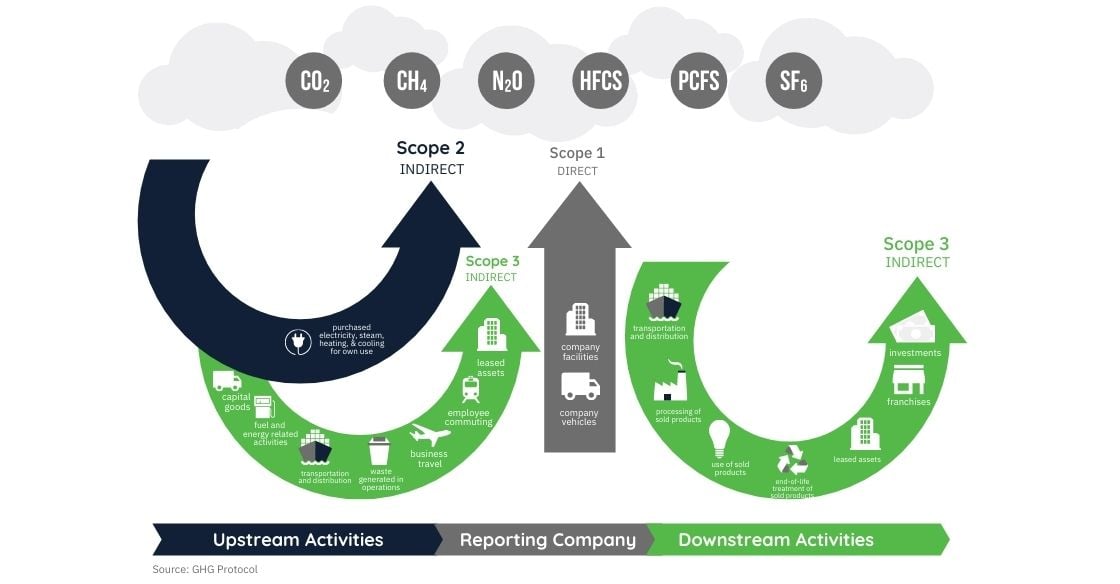Greenhouse Gas Carbon Reporting: How To Collect Supplier Data
In 2015, 196 countries signed the Paris Agreement, a legally binding treaty addressing the issue of climate change and aiming to reduce global warming. In 2021, President Biden brought the United States back into the deal. Partaking countries are undertaking ambitious initiatives to slow and hopefully reverse the impact of climate change on people, nature, and living species, most notably through the reduction of greenhouse gas carbon emissions (GHG).
Businesses must do their part and implement ways to measure and mitigate their carbon footprint throughout the entire supply chain and not just at the corporate level. Many organizations have already established carbon-neutrality strategies, aware of our collective responsibility as well as direct benefits for their bottom line.
Unlike the challenges posed by many programs using different methodologies, companies can use the GHG Protocol in conjunction with other programs to form a comprehensive and standardized accounting and reporting framework. As of now, the GHG Protocol is internationally recognized as a model for accountability and transparency.
In this article, we review the three scopes for measuring greenhouse gas carbon and how to successfully collect data upstream of the value chain.
GHG Impact and Supply Chain Management
Experts agree that the largest source of GHGs from human activities stems from burning fossil fuels. In its report, Inventory of U.S. Greenhouse Gas Emissions and Sinks, the EPA identifies the primary sources as:
- Transportation
- Production of electricity
- Industry operations
- Commercial and residential consumption
- Land use and forestry
Until recently, companies determined to participate in the effort have mainly worked toward improving their direct operations. But value chains and product portfolios are also areas worthy of attention, presenting numerous opportunities to make a difference.
GHG Protocol Scopes
Scope 1: Direct Emissions
Scope 1 greenhouse carbon emissions are ones we have direct control over, whether they come from sources you own or use. These sources range from company facilities (plants, offices) to fleets and fugitive emissions, including but not limited to:
- Electricity generation
- Heating and cooling
- Refrigerants
- Agricultural emissions
Scope 2: Indirect Emissions
Scope 2 GHGs cover the energy you need from external sources such as:
- Purchased electricity
- Steam
- Chilled water
Scope 3: Indirect Emissions in the Value Chain
Scope 3 are indirect emissions resulting from upstream or downstream activities.
Upstream
- Purchased goods and services
- Transportation and distribution
- Waste generation
- Business travel
- Employees commuting
Downstream
- Transportation and distribution to end-user
- Use of sold products
- End-of-life treatment
- Investments
Overview Of GHG Protocol Scopes And Emissions Across The Value Chain

While carbon dioxide release has been of great interest, all should know that producing goods and services contributes to emitting other damaging gases:
- Methane – CH4
- Nitrous oxide – N2O
- Hydrofluorocarbons - HFCs
- Perfluorocarbons - PFCs
- Sulfur hexafluoride - SF6
Scope 3 Data Collection and Reporting
Greenhouse gas carbon emissions are a concern for companies of all sizes and across every sector, from goods to financial services, as well as public institutions, government agencies, and schools. - Click To Tweet
When you dig a little deeper into the topic, you will find that Scope 3 activities may be the largest source of GHGs. And of all the steps taken to understand the impact your business has on climate change, data collection may be one of the most important for understanding how and where your upstream efforts are best allocated.
Collecting data and reporting on findings must be relevant, complete, consistent, transparent, and accurate. To that effect, the methods you deploy to gather data determine the validity of each requirement. Here are questions to keep in mind during the process:
- Relevance
Does your GHG inventory reflect the company’s emissions and support decisions?
- Completeness
Have you disclosed all sources and activities?
- Consistency
Is the same methodology used for all suppliers?
- Transparency
Are issues disclosed and documented via audits?
- Accuracy
Have you reduced uncertainties to a minimum and ensured data pertaining to greenhouse gas carbon emissions are as precise as possible?
Scope 3 data is likely to require the involvement of several departments like procurement, R&D, manufacturing, and marketing. Whether you strictly use the GHG Protocol or combine different approaches, your process should follow a simple pattern:
- Prioritize Data Collection
Determine which scope 3 activities have the most significant emissions, offer significant opportunities, and align with your business goals
- Select Relevant Data
You can obtain primary data directly from your suppliers and partners and secondary data from databases, statistics, and the like. Always keep data quality and relevance in mind, be it in terms of technology obsolescence, location, or reliability of the source.
- Collect Data And Identify Gaps
Engage your suppliers to share information from Tier 1 and up. Select relevant suppliers so as not to disperse your efforts in vain, as would be the case with small partners. Where information is incomplete or not accessible, use secondary data.
- Improve Data Quality Over Time
Collect. Assess. Improve. Time will contribute to a better understanding of the quality of data as even more data becomes available. Focus improvement efforts on low-quality data and high emissions.
Source Intelligence’s GHG Solution
Measuring your company’s carbon footprint is a project of great magnitude that requires extensive data collection and the capability to roll data into complex and exhaustive reports. In the US alone, upwards of 8,000 facilities are required to report annually, and such reports are publicly accessible.
Whether your company is subject to reporting in the States or in other countries, or you wish to capitalize on the benefits of identifying “hotspots” in your supply chain to promote sustainability, you need technology to perform the task.
Source Intelligence, the leader in AI-powered compliance solutions, has developed a Carbon Scope 3 reporting program based on the GHG Protocol to deliver the most complete and powerful solution on the market. From data selection, collection, and validation to sophisticated GHG inventory reporting capabilities, you can keep track of your performance at any given time and improve energy efficiency across your value chain.
Our solution lets you tailor the GHG emission factors to your specific needs and goals to automate the process and eliminate unnecessary manual work.
Request a demo of our greenhouse gas carbon program today to see how we can help.



